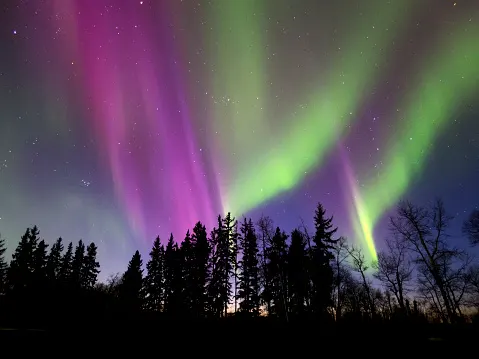
Still a chance to see the Northern Lights across parts of Canada tonight
Aurora-chasers in Alberta and Saskatchewan should keep their eyes to the skies tonight!
Update: After the arrival of the solar storm on Wednesday night, forecasters with NOAA's Space Weather Prediction Center determined that the initial estimate of its strength was too high. The weak magnetic field of the CME is not expected to spark a strong (G3) geomagnetic storm Thursday night.
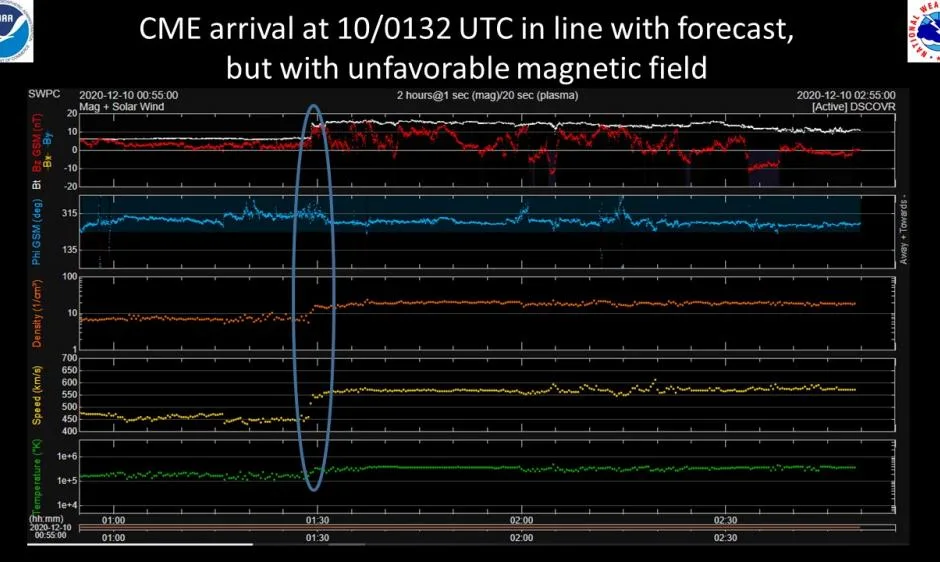
The latest update from the Space Weather Prediction Center, at 1:30 p.m. EST on December 10. Circled is the arrival time of the CME on Wednesday night, however the magnetic field of the cloud was not favourable for producing a strong geomagnetic storm. Credit: NOAA SWPC
Instead, SWPC has downgraded their watch to a minor (G1) geomagnetic storm. Auroras from this may extend into southern regions of Manitoba, Saskatchewan, and Alberta. The original story continues below...
After a solar flare blasted out from the Sun earlier this week, space weather forecasters alerted us of the potential for a geomagnetic storm, and a possible intense display of the Northern Lights across Canada and the northern United States.
It all started on Monday, December 7, when a sunspot designated as AR2790 emitted a small but still impressive-looking solar flare. Ranked as C7-class by space weather scientists, it wasn't very powerful (M-class and X-class are typically the ones to watch out for).
However, this solar flare was pointed almost directly at Earth, and forecasters noted that a 'coronal mass ejection' had erupted from the Sun at the same time.
According to NOAA's Space Weather Prediction Center, this Earth-directed coronal mass ejection (CME) arrived late on Wednesday, but a bit later than anticipated. While their original forecast called for the strongest auroras to become visible overnight Wednesday into Thursday, this has now been revised.
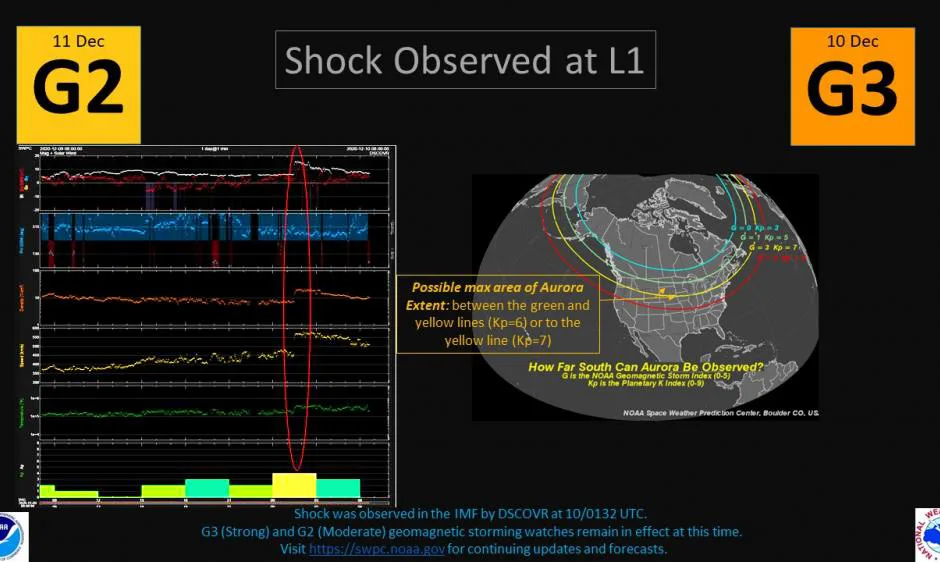
The graph (left) shows the arrival of the CME, as the magnetic field strength (white), density (orange), speed (yellow) and temperature (green) all abruptly rise at around 8:30 p.m. EST on Wednesday. The map (right), shows the potential southerly extent of the auroras on Thursday night. Credit: NOAA SWPC
They are now anticipating up to a strong (G3-level) geomagnetic storm for the evening of December 10. Moderate (G2-level) geomagnetic storming is also possible for the early morning hours of December 11. According to the SWPC forecasters, however, "confidence in storming reaching [G3 and G2] levels is diminishing."
Based on this space weather forecast and the terrestrial weather forecast, it appears as though skywatchers in Alberta, southern Saskatchewan, northern Manitoba, and northern Ontario will have the most favourable conditions to see the auroras Thursday night.
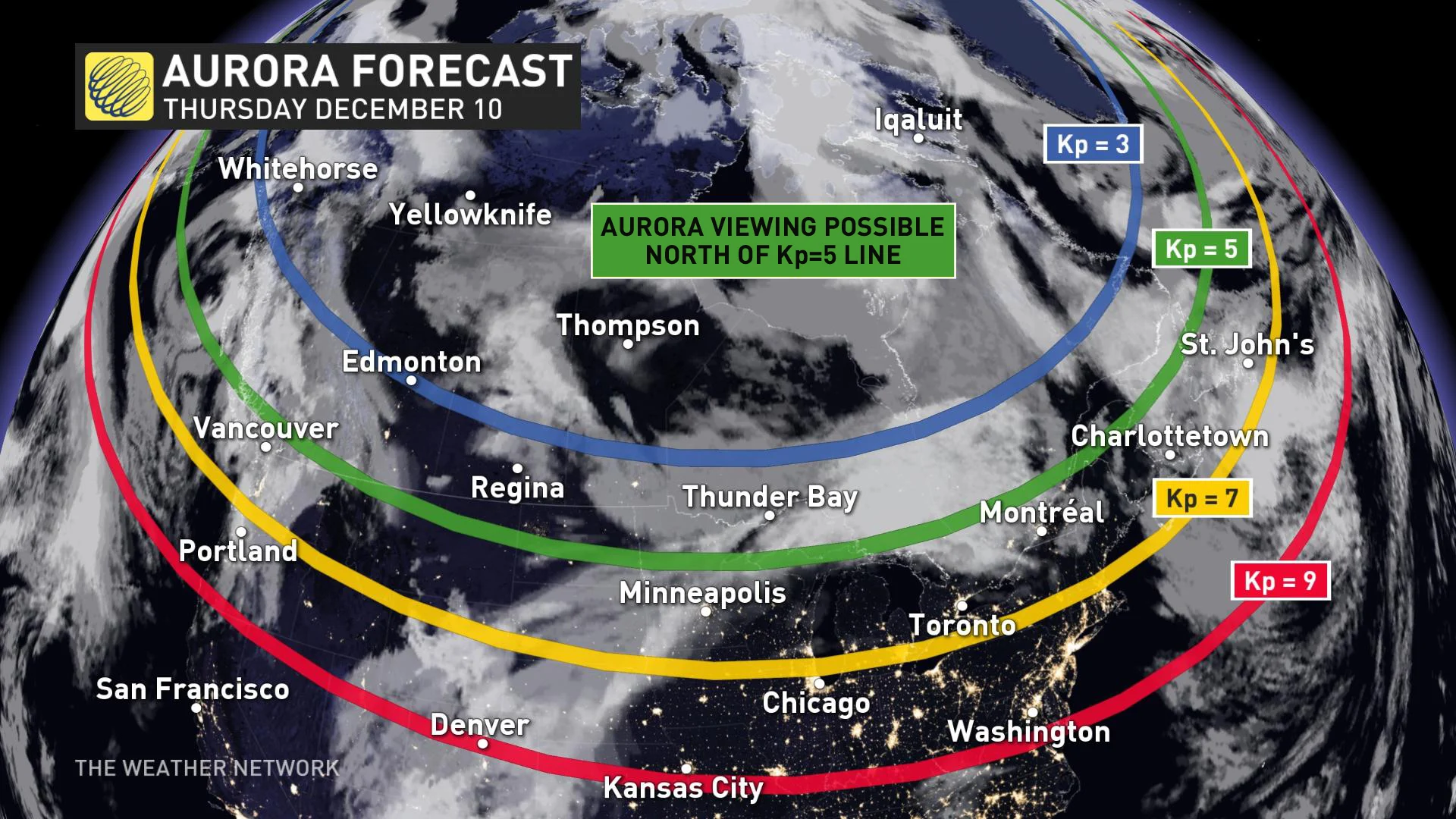
Updated forecast map with clouds and the expected extent of auroras from a G1 (minor) geomagnetic storm.
Clouds may spoil the view across British Columbia, northern Saskatchewan, southern Manitoba, and northwestern and northeastern Ontario. Much of Quebec, Newfoundland and Labrador, Prince Edward Island and Nova Scotia also appear to be overcast tonight.
Southern Ontario looks to have exceptionally clear skies, as does much of New Brunswick. Seeing the auroras from these locations, though, will depend on exacting when the strongest geomagnetic storming occurs.
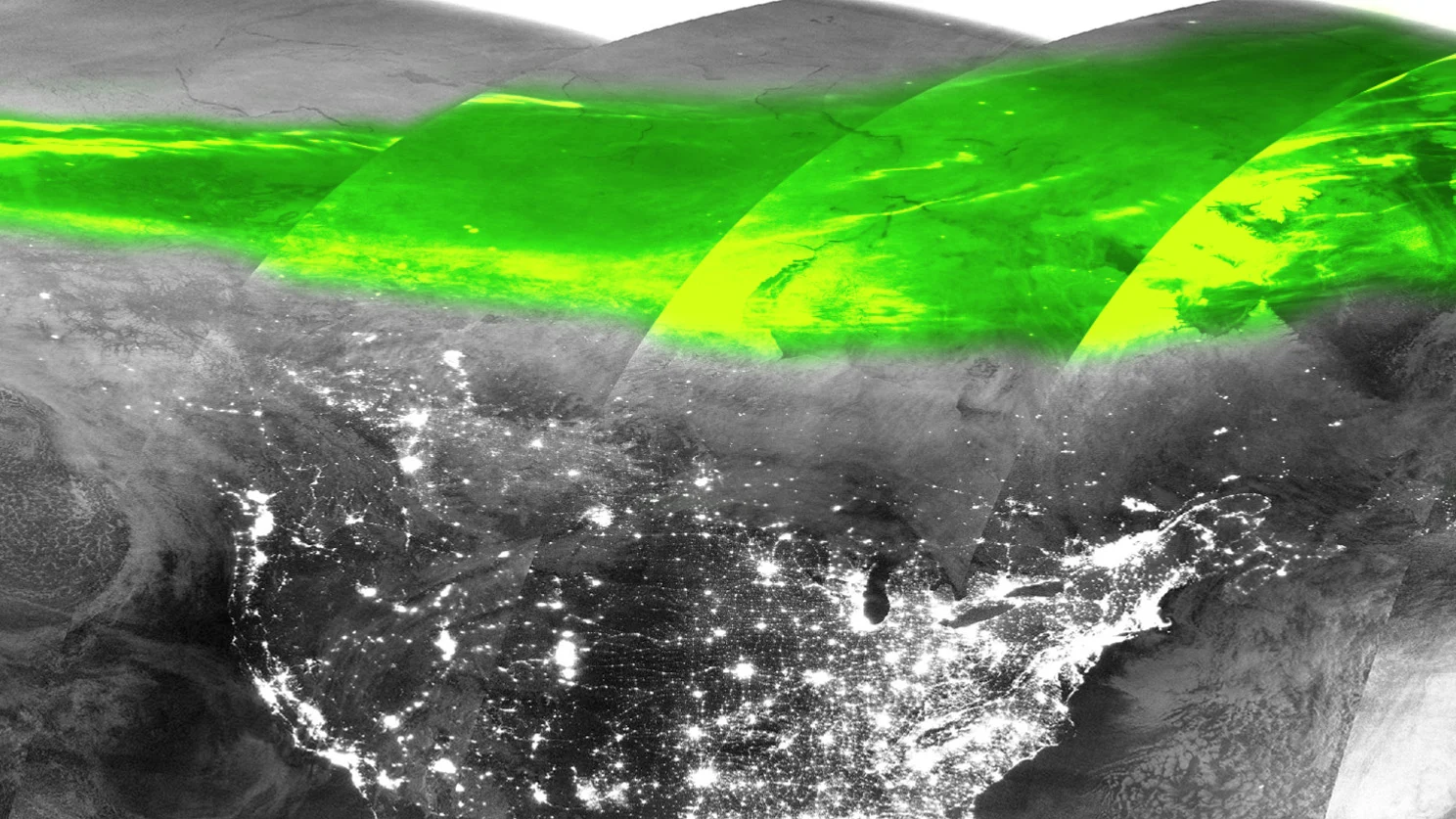
This composite image of nighttime imagery from the Suomi NPP satellite shows the extent of the auroras over Canada on the night of December 9-10, 2020. The green has been added to differentiate the auroras from clouds. Credit: NASA Worldview/Scott Sutherland
WHAT'S GOING ON HERE?
Solar flares and coronal mass ejections are both parts of what is known as space weather.
Solar flares are explosions on the surface of the Sun caused when tangled magnetic fields suddenly unravel and form new connections. This releases intense bursts of x-rays. Most solar flares are relatively weak, like Monday's C7-class flare. Some flares can be exceptionally powerful, though, saturating spacecraft instruments and plunging Earth's dayside into extreme radio blackouts.

These three views combine different coronagraph images taken by the Solar and Heliospheric Observatory (SOHO) on December 7, 2020. The coronagraph places a small disk directly beween the lens and the Sun, to capture features in the fainter corona. This sequence reveals the December 7 CME expanding away from the Sun (highlighted by the arrows). Credit: NASA/ESA
Coronal mass ejections (CMEs) are eruptions of magnetically charged plasma from the Sun, which usually accompany a solar flare. The tangled magnetic field lines where flares originate have billions of tonnes of solar material swirling around them at any time. So, when those new connections form, immense clouds of this solar matter become detatched from the Sun, and are suddenly accelerated away into space by the intense energy of the flare.
As a large moving cloud of charged particles (mostly electrons and protons), a CME carries with it both electric fields and magnetic fields. The speed and density of the CME, and the intensity of the cloud's magnetic field, determine how much of an impact it has, if any part of it encounters Earth's geomagnetic field.
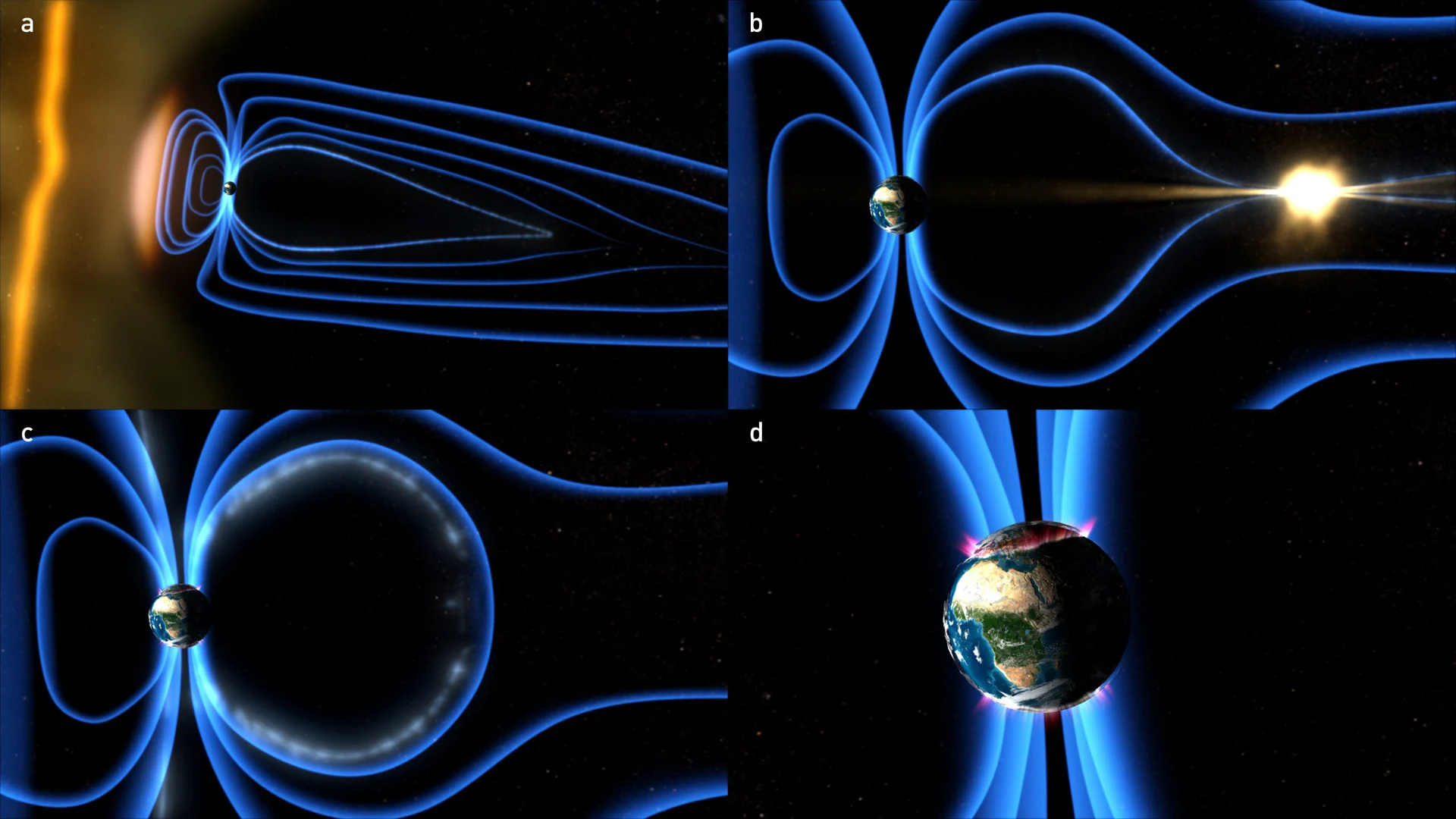
These four panels reveal the process of how a geomagnetic storm produces auroras. a) the CME arrives at Earth, pushing against the planet's magnetic field. b) solar particles from the cloud are trapped along the field lines, which draw together and 'reconnect'. c) the solar particles stream along the magnetic field loop, down into the upper atmosphere. d) auroras form when those particles interact with air molecules. Credit: NASA
Earth's magnetic field, which is generated by the planet's liquid metal core, acts like a protective shield against the solar wind and coronal mass ejections. However, when a CME sweeps past Earth the two magnetic fields interact with each other. This often results in a 'geomagnetic storm'.
The strongest of these geomagnetic storms - G4 (Severe) and G5 (Extreme) - have been known to cause problems with orbiting spacecraft and have even caused power blackouts.
Watch below: How to find the best aurora-spotting sites near you
While this disturbance is going on, some of the solar particles from the cloud become trapped in Earth's magnetic field and stream down into the upper atmosphere. There, these highly energetic particles smack into air molecules, transferring some of their energy, and the air molecules then emit this excess energy as flashes of light. The arcs and sheets of glowing air molecules produced by this process are what we call the Aurora Borealis or Aurora Australis - the Northern and Southern Lights.











